Project Plan for CQUniversity NAIDOC Week Event - PPMP20008
VerifiedAdded on 2022/12/15
|11
|2778
|216
Project
AI Summary
This project plan details the organization of NAIDOC Week celebrations across multiple CQUniversity campuses. It encompasses a project introduction, outlining background, description, major deliverables (five events), and justification through a Prince2 framework. Stakeholder analysis identifies key individuals and groups, assessing their interests, influence, and engagement levels. The plan addresses requirements management, including the Traditional Owners, opening statement styles, requirements gathering, traceability, and prioritization using the MoSCoW technique. Scope is defined with a Work Breakdown Structure (WBS) comprising six work packages, detailed in a WBS dictionary. The project schedule includes activity descriptions, start and end dates, and durations. A cost baseline is provided, estimating costs for each activity. Finally, a risk register highlights potential threats and opportunities, along with their impact and mitigation strategies. The project aims to increase awareness of Indigenous perspectives through various campus events, fostering cultural engagement and collaboration.

TERM 1 ASS_2
PROJECT PLAN
Student name Student number Qu/s responsible for.
Campus: Insert campus or distance
Tutor: Insert tutor name
Tutorial number: Insert the tutorial number
Notes to the Author
[This document is a template. It has been tailored to suit the assessment. All fields within the template should
be completed as per the project scenario provided.
Blue italicized text provides an explanation of what should be included for each section. Remove all
blue text prior to submission. If there are two or more options for you to decide between, revert
the option you are keeping to black and remove the other.
1
PROJECT PLAN
Student name Student number Qu/s responsible for.
Campus: Insert campus or distance
Tutor: Insert tutor name
Tutorial number: Insert the tutorial number
Notes to the Author
[This document is a template. It has been tailored to suit the assessment. All fields within the template should
be completed as per the project scenario provided.
Blue italicized text provides an explanation of what should be included for each section. Remove all
blue text prior to submission. If there are two or more options for you to decide between, revert
the option you are keeping to black and remove the other.
1
Paraphrase This Document
Need a fresh take? Get an instant paraphrase of this document with our AI Paraphraser
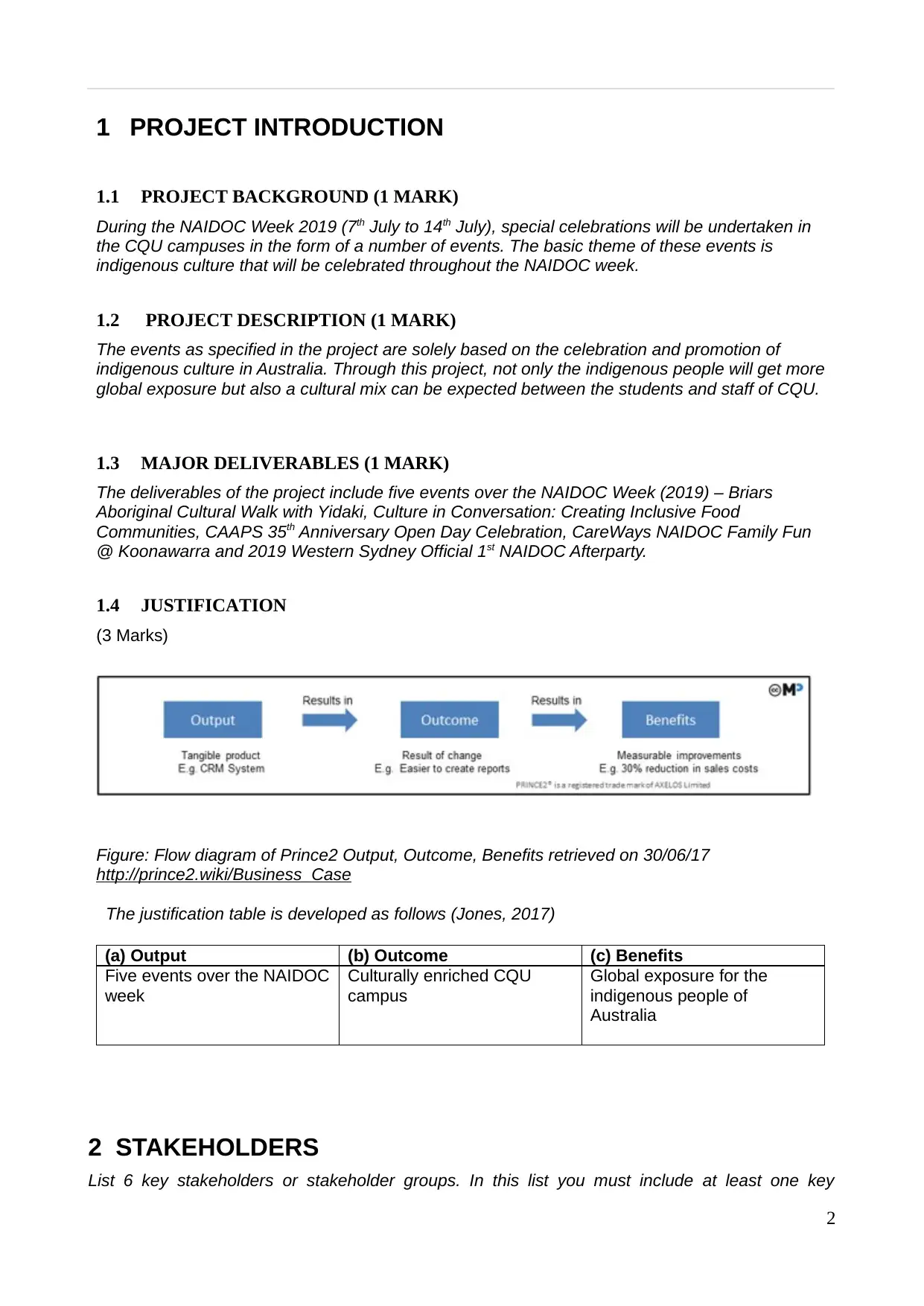
1 PROJECT INTRODUCTION
1.1 PROJECT BACKGROUND (1 MARK)
During the NAIDOC Week 2019 (7th July to 14th July), special celebrations will be undertaken in
the CQU campuses in the form of a number of events. The basic theme of these events is
indigenous culture that will be celebrated throughout the NAIDOC week.
1.2 PROJECT DESCRIPTION (1 MARK)
The events as specified in the project are solely based on the celebration and promotion of
indigenous culture in Australia. Through this project, not only the indigenous people will get more
global exposure but also a cultural mix can be expected between the students and staff of CQU.
1.3 MAJOR DELIVERABLES (1 MARK)
The deliverables of the project include five events over the NAIDOC Week (2019) – Briars
Aboriginal Cultural Walk with Yidaki, Culture in Conversation: Creating Inclusive Food
Communities, CAAPS 35th Anniversary Open Day Celebration, CareWays NAIDOC Family Fun
@ Koonawarra and 2019 Western Sydney Official 1st NAIDOC Afterparty.
1.4 JUSTIFICATION
(3 Marks)
Figure: Flow diagram of Prince2 Output, Outcome, Benefits retrieved on 30/06/17
http://prince2.wiki/Business_Case
The justification table is developed as follows (Jones, 2017)
(a) Output (b) Outcome (c) Benefits
Five events over the NAIDOC
week
Culturally enriched CQU
campus
Global exposure for the
indigenous people of
Australia
2 STAKEHOLDERS
List 6 key stakeholders or stakeholder groups. In this list you must include at least one key
2
1.1 PROJECT BACKGROUND (1 MARK)
During the NAIDOC Week 2019 (7th July to 14th July), special celebrations will be undertaken in
the CQU campuses in the form of a number of events. The basic theme of these events is
indigenous culture that will be celebrated throughout the NAIDOC week.
1.2 PROJECT DESCRIPTION (1 MARK)
The events as specified in the project are solely based on the celebration and promotion of
indigenous culture in Australia. Through this project, not only the indigenous people will get more
global exposure but also a cultural mix can be expected between the students and staff of CQU.
1.3 MAJOR DELIVERABLES (1 MARK)
The deliverables of the project include five events over the NAIDOC Week (2019) – Briars
Aboriginal Cultural Walk with Yidaki, Culture in Conversation: Creating Inclusive Food
Communities, CAAPS 35th Anniversary Open Day Celebration, CareWays NAIDOC Family Fun
@ Koonawarra and 2019 Western Sydney Official 1st NAIDOC Afterparty.
1.4 JUSTIFICATION
(3 Marks)
Figure: Flow diagram of Prince2 Output, Outcome, Benefits retrieved on 30/06/17
http://prince2.wiki/Business_Case
The justification table is developed as follows (Jones, 2017)
(a) Output (b) Outcome (c) Benefits
Five events over the NAIDOC
week
Culturally enriched CQU
campus
Global exposure for the
indigenous people of
Australia
2 STAKEHOLDERS
List 6 key stakeholders or stakeholder groups. In this list you must include at least one key
2
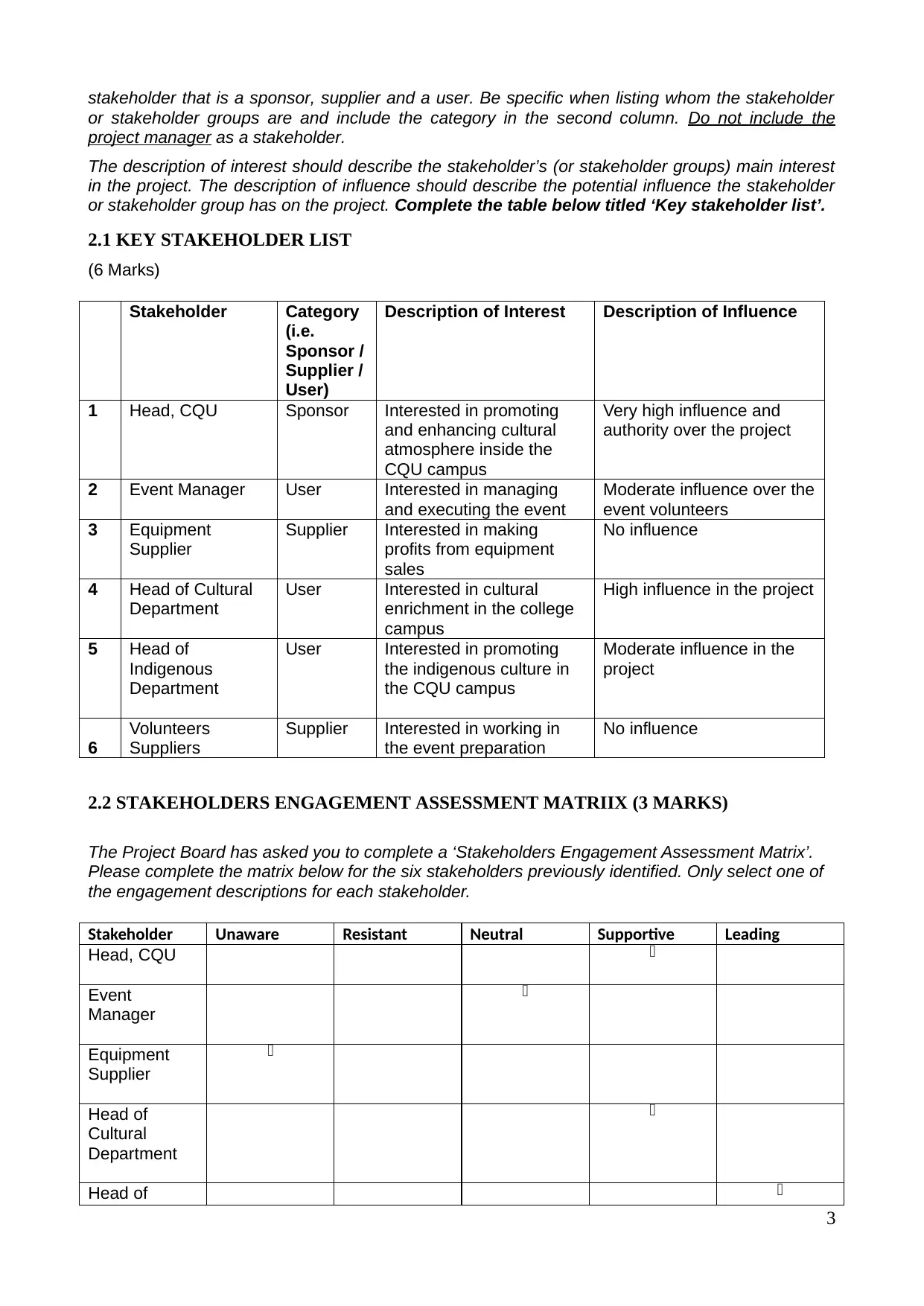
stakeholder that is a sponsor, supplier and a user. Be specific when listing whom the stakeholder
or stakeholder groups are and include the category in the second column. Do not include the
project manager as a stakeholder.
The description of interest should describe the stakeholder’s (or stakeholder groups) main interest
in the project. The description of influence should describe the potential influence the stakeholder
or stakeholder group has on the project. Complete the table below titled ‘Key stakeholder list’.
2.1 KEY STAKEHOLDER LIST
(6 Marks)
Stakeholder Category
(i.e.
Sponsor /
Supplier /
User)
Description of Interest Description of Influence
1 Head, CQU Sponsor Interested in promoting
and enhancing cultural
atmosphere inside the
CQU campus
Very high influence and
authority over the project
2 Event Manager User Interested in managing
and executing the event
Moderate influence over the
event volunteers
3 Equipment
Supplier
Supplier Interested in making
profits from equipment
sales
No influence
4 Head of Cultural
Department
User Interested in cultural
enrichment in the college
campus
High influence in the project
5 Head of
Indigenous
Department
User Interested in promoting
the indigenous culture in
the CQU campus
Moderate influence in the
project
6
Volunteers
Suppliers
Supplier Interested in working in
the event preparation
No influence
2.2 STAKEHOLDERS ENGAGEMENT ASSESSMENT MATRIIX (3 MARKS)
The Project Board has asked you to complete a ‘Stakeholders Engagement Assessment Matrix’.
Please complete the matrix below for the six stakeholders previously identified. Only select one of
the engagement descriptions for each stakeholder.
Stakeholder Unaware Resistant Neutral Supportive Leading
Head, CQU
Event
Manager
Equipment
Supplier
Head of
Cultural
Department
Head of
3
or stakeholder groups are and include the category in the second column. Do not include the
project manager as a stakeholder.
The description of interest should describe the stakeholder’s (or stakeholder groups) main interest
in the project. The description of influence should describe the potential influence the stakeholder
or stakeholder group has on the project. Complete the table below titled ‘Key stakeholder list’.
2.1 KEY STAKEHOLDER LIST
(6 Marks)
Stakeholder Category
(i.e.
Sponsor /
Supplier /
User)
Description of Interest Description of Influence
1 Head, CQU Sponsor Interested in promoting
and enhancing cultural
atmosphere inside the
CQU campus
Very high influence and
authority over the project
2 Event Manager User Interested in managing
and executing the event
Moderate influence over the
event volunteers
3 Equipment
Supplier
Supplier Interested in making
profits from equipment
sales
No influence
4 Head of Cultural
Department
User Interested in cultural
enrichment in the college
campus
High influence in the project
5 Head of
Indigenous
Department
User Interested in promoting
the indigenous culture in
the CQU campus
Moderate influence in the
project
6
Volunteers
Suppliers
Supplier Interested in working in
the event preparation
No influence
2.2 STAKEHOLDERS ENGAGEMENT ASSESSMENT MATRIIX (3 MARKS)
The Project Board has asked you to complete a ‘Stakeholders Engagement Assessment Matrix’.
Please complete the matrix below for the six stakeholders previously identified. Only select one of
the engagement descriptions for each stakeholder.
Stakeholder Unaware Resistant Neutral Supportive Leading
Head, CQU
Event
Manager
Equipment
Supplier
Head of
Cultural
Department
Head of
3
⊘ This is a preview!⊘
Do you want full access?
Subscribe today to unlock all pages.

Trusted by 1+ million students worldwide
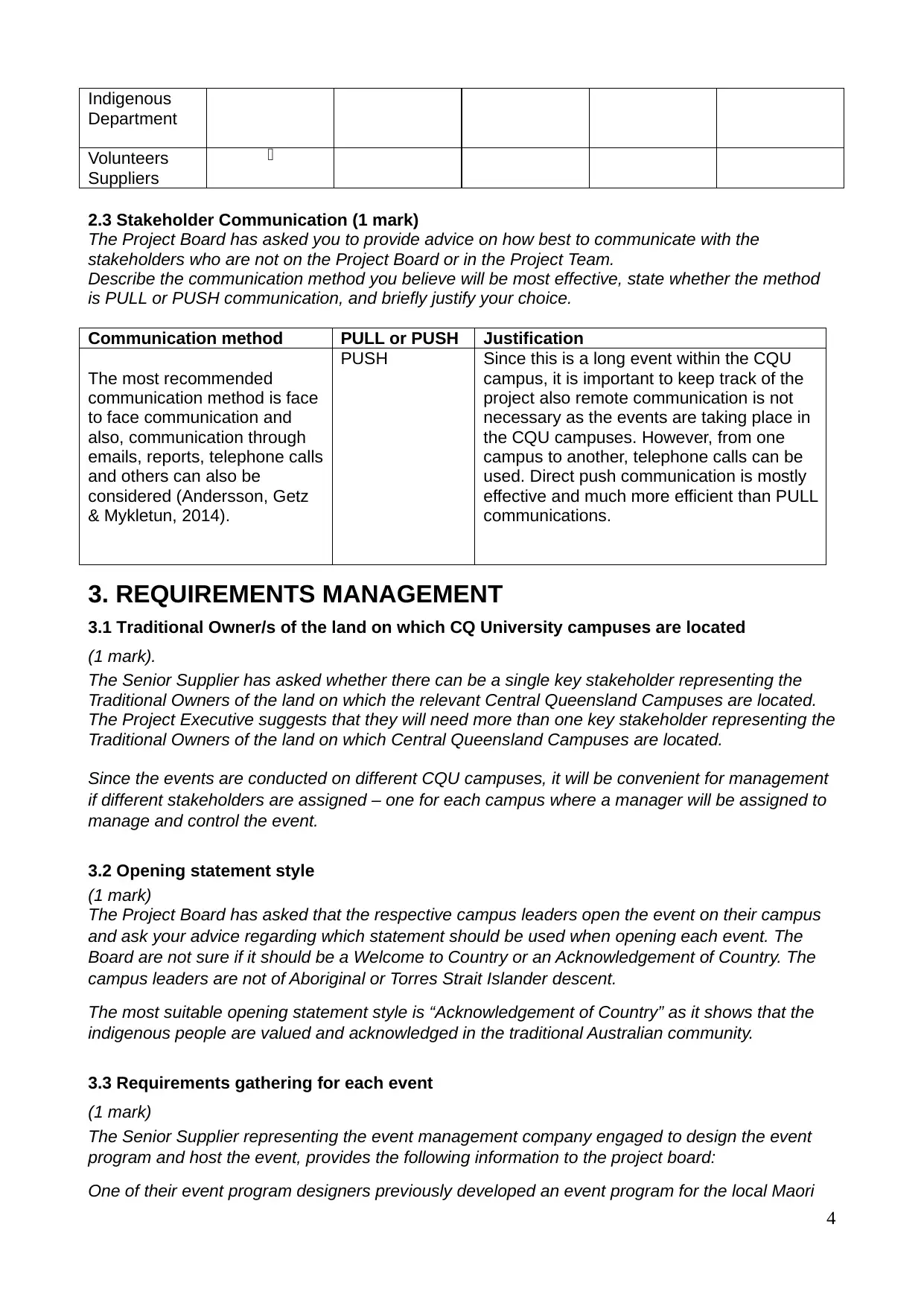
Indigenous
Department
Volunteers
Suppliers
2.3 Stakeholder Communication (1 mark)
The Project Board has asked you to provide advice on how best to communicate with the
stakeholders who are not on the Project Board or in the Project Team.
Describe the communication method you believe will be most effective, state whether the method
is PULL or PUSH communication, and briefly justify your choice.
Communication method PULL or PUSH Justification
The most recommended
communication method is face
to face communication and
also, communication through
emails, reports, telephone calls
and others can also be
considered (Andersson, Getz
& Mykletun, 2014).
PUSH Since this is a long event within the CQU
campus, it is important to keep track of the
project also remote communication is not
necessary as the events are taking place in
the CQU campuses. However, from one
campus to another, telephone calls can be
used. Direct push communication is mostly
effective and much more efficient than PULL
communications.
3. REQUIREMENTS MANAGEMENT
3.1 Traditional Owner/s of the land on which CQ University campuses are located
(1 mark).
The Senior Supplier has asked whether there can be a single key stakeholder representing the
Traditional Owners of the land on which the relevant Central Queensland Campuses are located.
The Project Executive suggests that they will need more than one key stakeholder representing the
Traditional Owners of the land on which Central Queensland Campuses are located.
Since the events are conducted on different CQU campuses, it will be convenient for management
if different stakeholders are assigned – one for each campus where a manager will be assigned to
manage and control the event.
3.2 Opening statement style
(1 mark)
The Project Board has asked that the respective campus leaders open the event on their campus
and ask your advice regarding which statement should be used when opening each event. The
Board are not sure if it should be a Welcome to Country or an Acknowledgement of Country. The
campus leaders are not of Aboriginal or Torres Strait Islander descent.
The most suitable opening statement style is “Acknowledgement of Country” as it shows that the
indigenous people are valued and acknowledged in the traditional Australian community.
3.3 Requirements gathering for each event
(1 mark)
The Senior Supplier representing the event management company engaged to design the event
program and host the event, provides the following information to the project board:
One of their event program designers previously developed an event program for the local Maori
4
Department
Volunteers
Suppliers
2.3 Stakeholder Communication (1 mark)
The Project Board has asked you to provide advice on how best to communicate with the
stakeholders who are not on the Project Board or in the Project Team.
Describe the communication method you believe will be most effective, state whether the method
is PULL or PUSH communication, and briefly justify your choice.
Communication method PULL or PUSH Justification
The most recommended
communication method is face
to face communication and
also, communication through
emails, reports, telephone calls
and others can also be
considered (Andersson, Getz
& Mykletun, 2014).
PUSH Since this is a long event within the CQU
campus, it is important to keep track of the
project also remote communication is not
necessary as the events are taking place in
the CQU campuses. However, from one
campus to another, telephone calls can be
used. Direct push communication is mostly
effective and much more efficient than PULL
communications.
3. REQUIREMENTS MANAGEMENT
3.1 Traditional Owner/s of the land on which CQ University campuses are located
(1 mark).
The Senior Supplier has asked whether there can be a single key stakeholder representing the
Traditional Owners of the land on which the relevant Central Queensland Campuses are located.
The Project Executive suggests that they will need more than one key stakeholder representing the
Traditional Owners of the land on which Central Queensland Campuses are located.
Since the events are conducted on different CQU campuses, it will be convenient for management
if different stakeholders are assigned – one for each campus where a manager will be assigned to
manage and control the event.
3.2 Opening statement style
(1 mark)
The Project Board has asked that the respective campus leaders open the event on their campus
and ask your advice regarding which statement should be used when opening each event. The
Board are not sure if it should be a Welcome to Country or an Acknowledgement of Country. The
campus leaders are not of Aboriginal or Torres Strait Islander descent.
The most suitable opening statement style is “Acknowledgement of Country” as it shows that the
indigenous people are valued and acknowledged in the traditional Australian community.
3.3 Requirements gathering for each event
(1 mark)
The Senior Supplier representing the event management company engaged to design the event
program and host the event, provides the following information to the project board:
One of their event program designers previously developed an event program for the local Maori
4
Paraphrase This Document
Need a fresh take? Get an instant paraphrase of this document with our AI Paraphraser

community group. The designer is confident they could utilise the same event program and modify
the content by researching the language, customs and protocols online. They suggest by using
desktop research only will save both time and money, as there would be no need to contact
anyone outside the current project team.
It is not recommended for this project to use previous years’ plan. The design of the events is to be
started afresh with new additions and modifications that will help the event to gain success.
Moreover, previous year’s design may have some issues and problems that have not been
documented and hence, it is recommended to avoid the same accordingly.
3.4 Requirements traceability
(1 mark)
As multiple campuses will be involved in the project, the project board has requested requirements
be tracked centrally. What document is used to track or ‘trace’ requirements throughout the
project life cycle?
Project tracking reports can be prepared for tracking requirements through the project life cycle.
Another effective document that can be used for the same purpose is a Gantt chart in which all
activities can be listed along with time schedules. It is very convenient to use a Gantt chart for
scheduling and tracking of requirements throughout the project life cycle.
3.5 Requirements prioritization process
(2 mark)
The project board are concerned they may have competing requirements from a number of
stakeholders. To manage this they would like to define a requirement prioritisation process that can
be shared with all stakeholders prior to requirements gathering and want to use the MoSCoW
technique for this purpose. List the four components of the MoSCoW technique and explain
each component.
Component name Component explanation
Must have Unavoidable for the project
Should have Required for the project but not necessary
Could have Possibility of using for project
Would have No value in the project
4 SCOPE
4.1 WP NUMBER RESTRICTION
The project board wants no more than six work packages for the project. Explain what the benefit
to combining activities into a limited amount of work packages? (1 mark)
The benefit of combination of the activities into work packages is that the project schedule / wbs
developed are compact and easily understandable for the project manager.
4.2 WORK BREAKDOWN DIAGRAM
Complete the WBS below. It must comprise 3 levels and 6 work packages. Please note: The third
level comprises work packages. You need to insert a name and id in each of these work packages.
5
the content by researching the language, customs and protocols online. They suggest by using
desktop research only will save both time and money, as there would be no need to contact
anyone outside the current project team.
It is not recommended for this project to use previous years’ plan. The design of the events is to be
started afresh with new additions and modifications that will help the event to gain success.
Moreover, previous year’s design may have some issues and problems that have not been
documented and hence, it is recommended to avoid the same accordingly.
3.4 Requirements traceability
(1 mark)
As multiple campuses will be involved in the project, the project board has requested requirements
be tracked centrally. What document is used to track or ‘trace’ requirements throughout the
project life cycle?
Project tracking reports can be prepared for tracking requirements through the project life cycle.
Another effective document that can be used for the same purpose is a Gantt chart in which all
activities can be listed along with time schedules. It is very convenient to use a Gantt chart for
scheduling and tracking of requirements throughout the project life cycle.
3.5 Requirements prioritization process
(2 mark)
The project board are concerned they may have competing requirements from a number of
stakeholders. To manage this they would like to define a requirement prioritisation process that can
be shared with all stakeholders prior to requirements gathering and want to use the MoSCoW
technique for this purpose. List the four components of the MoSCoW technique and explain
each component.
Component name Component explanation
Must have Unavoidable for the project
Should have Required for the project but not necessary
Could have Possibility of using for project
Would have No value in the project
4 SCOPE
4.1 WP NUMBER RESTRICTION
The project board wants no more than six work packages for the project. Explain what the benefit
to combining activities into a limited amount of work packages? (1 mark)
The benefit of combination of the activities into work packages is that the project schedule / wbs
developed are compact and easily understandable for the project manager.
4.2 WORK BREAKDOWN DIAGRAM
Complete the WBS below. It must comprise 3 levels and 6 work packages. Please note: The third
level comprises work packages. You need to insert a name and id in each of these work packages.
5
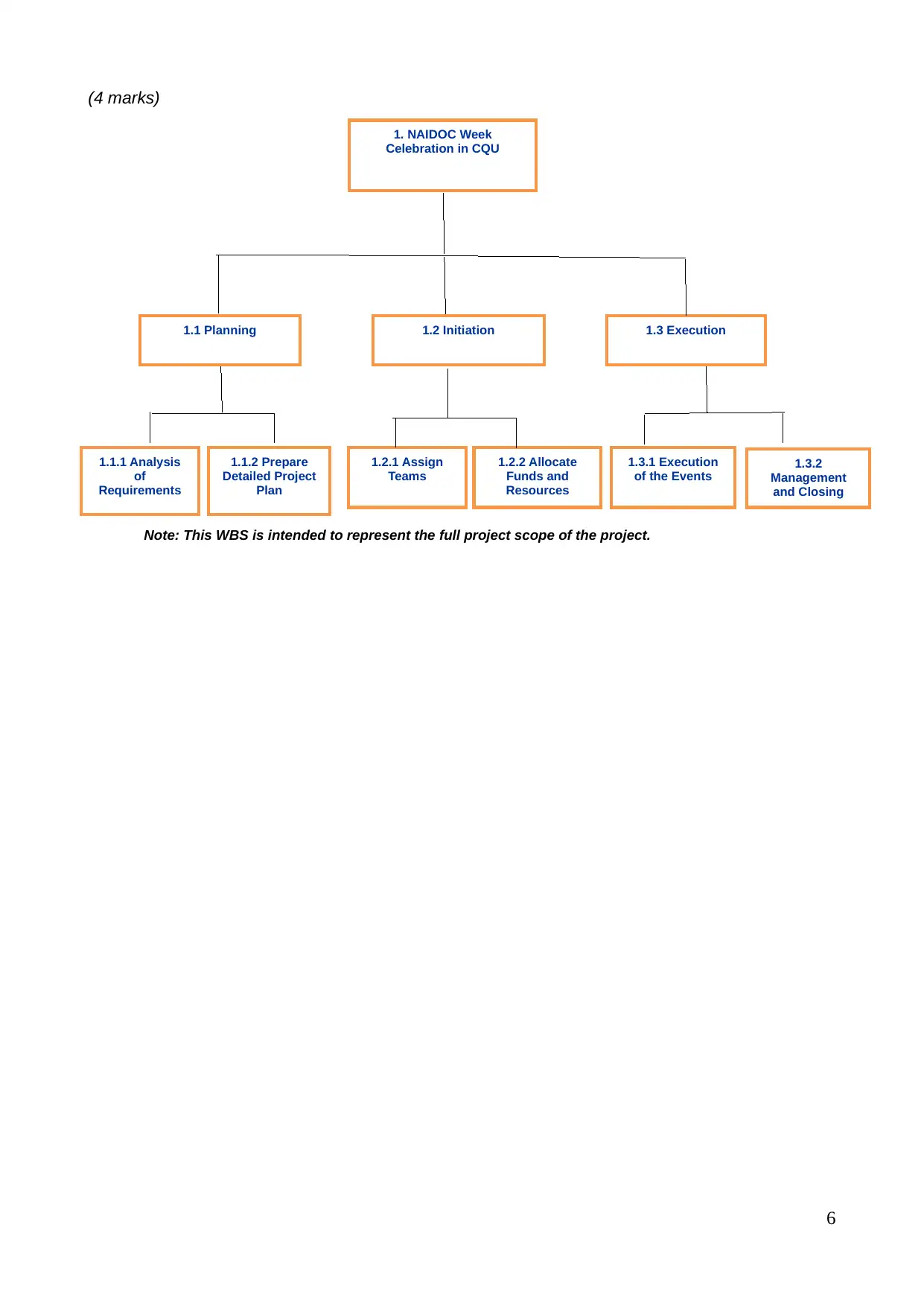
(4 marks)
Note: This WBS is intended to represent the full project scope of the project.
6
1. NAIDOC Week
Celebration in CQU
1.3 Execution1.2 Initiation1.1 Planning
1.3.2
Management
and Closing
1.3.1 Execution
of the Events
1.2.2 Allocate
Funds and
Resources
1.2.1 Assign
Teams
1.1.2 Prepare
Detailed Project
Plan
1.1.1 Analysis
of
Requirements
Note: This WBS is intended to represent the full project scope of the project.
6
1. NAIDOC Week
Celebration in CQU
1.3 Execution1.2 Initiation1.1 Planning
1.3.2
Management
and Closing
1.3.1 Execution
of the Events
1.2.2 Allocate
Funds and
Resources
1.2.1 Assign
Teams
1.1.2 Prepare
Detailed Project
Plan
1.1.1 Analysis
of
Requirements
⊘ This is a preview!⊘
Do you want full access?
Subscribe today to unlock all pages.

Trusted by 1+ million students worldwide
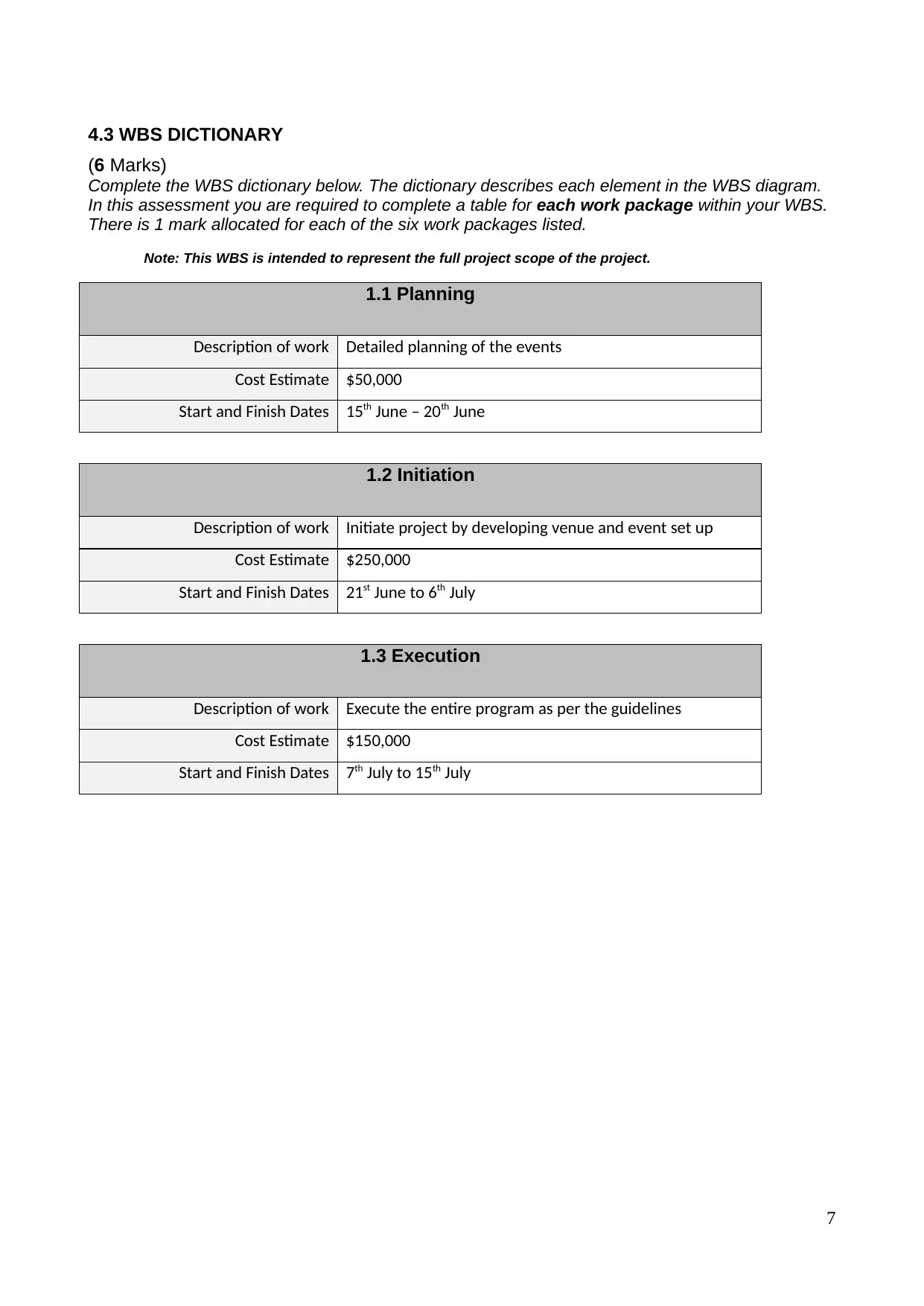
4.3 WBS DICTIONARY
(6 Marks)
Complete the WBS dictionary below. The dictionary describes each element in the WBS diagram.
In this assessment you are required to complete a table for each work package within your WBS.
There is 1 mark allocated for each of the six work packages listed.
Note: This WBS is intended to represent the full project scope of the project.
1.1 Planning
Description of work Detailed planning of the events
Cost Estimate $50,000
Start and Finish Dates 15th June – 20th June
1.2 Initiation
Description of work Initiate project by developing venue and event set up
Cost Estimate $250,000
Start and Finish Dates 21st June to 6th July
1.3 Execution
Description of work Execute the entire program as per the guidelines
Cost Estimate $150,000
Start and Finish Dates 7th July to 15th July
7
(6 Marks)
Complete the WBS dictionary below. The dictionary describes each element in the WBS diagram.
In this assessment you are required to complete a table for each work package within your WBS.
There is 1 mark allocated for each of the six work packages listed.
Note: This WBS is intended to represent the full project scope of the project.
1.1 Planning
Description of work Detailed planning of the events
Cost Estimate $50,000
Start and Finish Dates 15th June – 20th June
1.2 Initiation
Description of work Initiate project by developing venue and event set up
Cost Estimate $250,000
Start and Finish Dates 21st June to 6th July
1.3 Execution
Description of work Execute the entire program as per the guidelines
Cost Estimate $150,000
Start and Finish Dates 7th July to 15th July
7
Paraphrase This Document
Need a fresh take? Get an instant paraphrase of this document with our AI Paraphraser

5 SCHEDULE (6 MARKS)
The project executive has asked that the project work be completed in time for NAIDOC
week this year. However, project work cannot be started earlier than 14 May. You must
include the work package name and id
In the tables that follow, list at least two (2) work activities for each of the six (6) work
packages selected. Also include the start and end dates and duration in days for each
activity.
1.1 Planning
Activity Description of work Start
Date
End
Date
Duration
(days)
1.1.1 Analysis of
Requirements
Analysis of event requirements 15th
June
17th
Jun
e
3
1.1.2 Prepare Detailed
Project Plan
Development of Project Plan for Project 18th
June
20th
Jun
e
3
1.2 Initiation
Activity Description of work Start
Date
End
Date
Duration
(days)
1.2.1 Assign Teams Assign teams to various activities 21st
June
6th
July
16
1.2.2 Allocate Funds
and Resources
Allocate funds and resources to team 21st
June
6th
July
16
1.3 Execution
Activity Description of work Start
Date
End
Date
Duration
(days)
1.3.1 Execution of the
Events
Execute the event as per the plan 8th
July
14th
July
7
1.3.2 Management and
Closing
Manage event participants and closing
the event after it is over
8th
July
14th
July
7
8
The project executive has asked that the project work be completed in time for NAIDOC
week this year. However, project work cannot be started earlier than 14 May. You must
include the work package name and id
In the tables that follow, list at least two (2) work activities for each of the six (6) work
packages selected. Also include the start and end dates and duration in days for each
activity.
1.1 Planning
Activity Description of work Start
Date
End
Date
Duration
(days)
1.1.1 Analysis of
Requirements
Analysis of event requirements 15th
June
17th
Jun
e
3
1.1.2 Prepare Detailed
Project Plan
Development of Project Plan for Project 18th
June
20th
Jun
e
3
1.2 Initiation
Activity Description of work Start
Date
End
Date
Duration
(days)
1.2.1 Assign Teams Assign teams to various activities 21st
June
6th
July
16
1.2.2 Allocate Funds
and Resources
Allocate funds and resources to team 21st
June
6th
July
16
1.3 Execution
Activity Description of work Start
Date
End
Date
Duration
(days)
1.3.1 Execution of the
Events
Execute the event as per the plan 8th
July
14th
July
7
1.3.2 Management and
Closing
Manage event participants and closing
the event after it is over
8th
July
14th
July
7
8
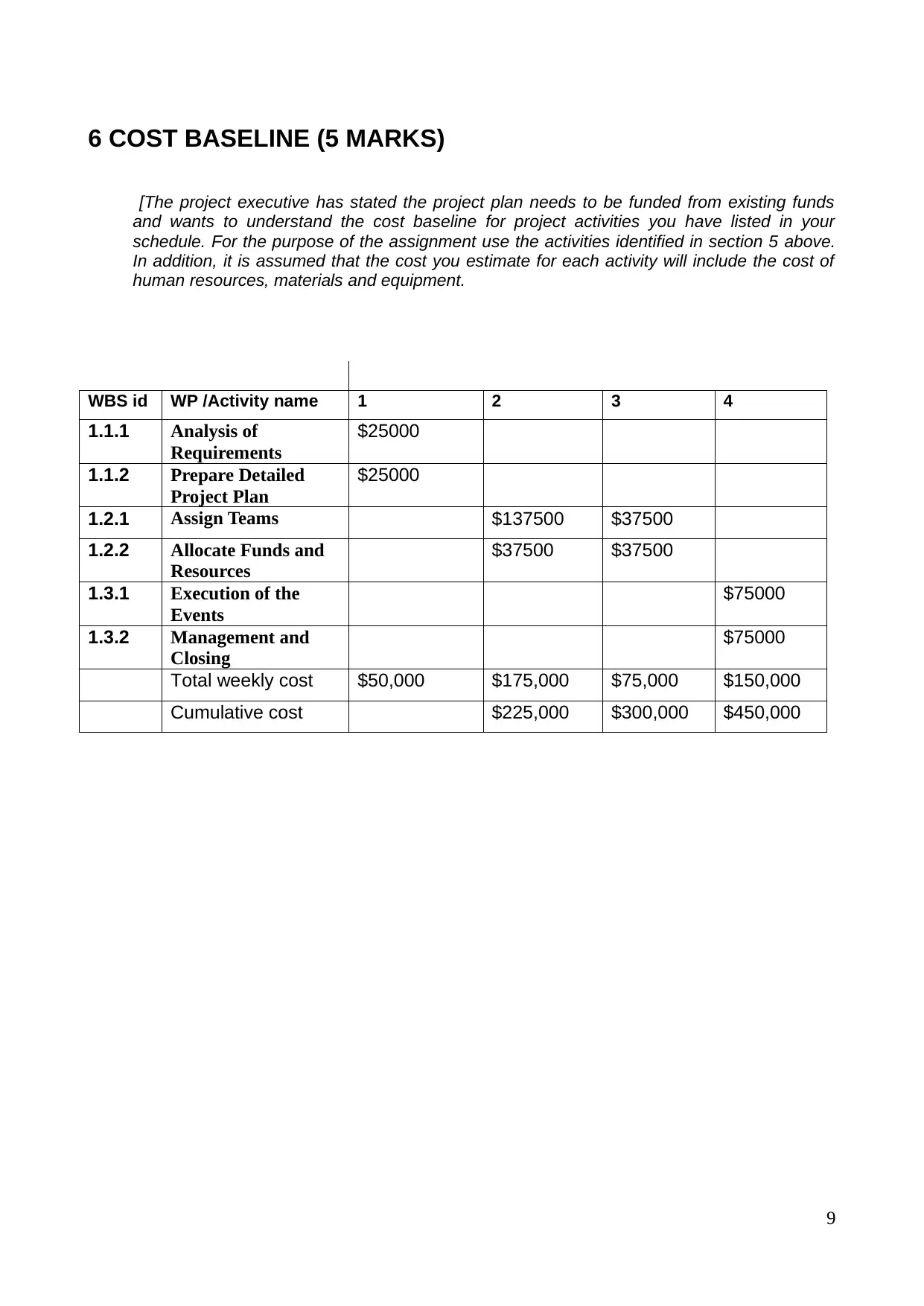
6 COST BASELINE (5 MARKS)
[The project executive has stated the project plan needs to be funded from existing funds
and wants to understand the cost baseline for project activities you have listed in your
schedule. For the purpose of the assignment use the activities identified in section 5 above.
In addition, it is assumed that the cost you estimate for each activity will include the cost of
human resources, materials and equipment.
WBS id WP /Activity name 1 2 3 4
1.1.1 Analysis of
Requirements
$25000
1.1.2 Prepare Detailed
Project Plan
$25000
1.2.1 Assign Teams $137500 $37500
1.2.2 Allocate Funds and
Resources
$37500 $37500
1.3.1 Execution of the
Events
$75000
1.3.2 Management and
Closing
$75000
Total weekly cost $50,000 $175,000 $75,000 $150,000
Cumulative cost $225,000 $300,000 $450,000
9
[The project executive has stated the project plan needs to be funded from existing funds
and wants to understand the cost baseline for project activities you have listed in your
schedule. For the purpose of the assignment use the activities identified in section 5 above.
In addition, it is assumed that the cost you estimate for each activity will include the cost of
human resources, materials and equipment.
WBS id WP /Activity name 1 2 3 4
1.1.1 Analysis of
Requirements
$25000
1.1.2 Prepare Detailed
Project Plan
$25000
1.2.1 Assign Teams $137500 $37500
1.2.2 Allocate Funds and
Resources
$37500 $37500
1.3.1 Execution of the
Events
$75000
1.3.2 Management and
Closing
$75000
Total weekly cost $50,000 $175,000 $75,000 $150,000
Cumulative cost $225,000 $300,000 $450,000
9
⊘ This is a preview!⊘
Do you want full access?
Subscribe today to unlock all pages.

Trusted by 1+ million students worldwide

7 RISKS
(3 marks)
Complete the condensed risk register below to describe three (3) risks associated with the
project. The three (3) risks are to include two (2) threats and one (1) opportunity. As the cost
will be coming from existing budgets and the timeframes cannot be changed, do not include
risks about restricted funding or time.
Risk Register
Name Description Likelihood Impact Response
type
Mitigation strategy
Threat Very small
participation due to
lack of interest
3 4 External Advertise the event much prior
to the event
Threat Negative thoughts of
the staff and
students against
indigenous people
4 5 Internal No negative or racist comments
and aggressive behaviour
against the indigenous people
Opportunity No participation of
indigenous people
5 3 Internal Spread the word about event
among indigenous people and
call them to come ahead and
join the events.
8 TOLERENCES
(1 mark) In the table below indicate what tolerance is specified in the project for cost and time only.
Tolerance Specific Tolerance allowed
Tolerance specified for time No tolerance is acceptable
Tolerance specified for cost Upto $20,000 extra is tolerable
9 LESSONS
(2 marks) One of the project team members shared a lesson learnt from a previous similar project
in which they were involved. The lesson involved problems encountered with attendance of
students and staff to campus events. Attendance was low when students and staff perceived that
the event did not relate to them or they had little interest in the theme. Considering the lesson
above and the NAIDOC week theme, complete the table below proposing a specific activity to be
added to the project scope that you believe will address this previous lesson. State which work
package the activity should be added to.
Previous lessons
learned
Why did the
presenters find the
question insulting?
Proposed activity to
address the lesson
(in current project)
Work package
which activity will
be added
Lesson 1
At a previous event, an
audience member asked
the following question
‘Why don’t Aboriginal and
Somehow, the
question challenges
the freedom of the
indigenous people
While making contractual
agreements, make it clear
to the team that these
types of activities are not
desired and must be
1.2.1. Assign Teams
10
(3 marks)
Complete the condensed risk register below to describe three (3) risks associated with the
project. The three (3) risks are to include two (2) threats and one (1) opportunity. As the cost
will be coming from existing budgets and the timeframes cannot be changed, do not include
risks about restricted funding or time.
Risk Register
Name Description Likelihood Impact Response
type
Mitigation strategy
Threat Very small
participation due to
lack of interest
3 4 External Advertise the event much prior
to the event
Threat Negative thoughts of
the staff and
students against
indigenous people
4 5 Internal No negative or racist comments
and aggressive behaviour
against the indigenous people
Opportunity No participation of
indigenous people
5 3 Internal Spread the word about event
among indigenous people and
call them to come ahead and
join the events.
8 TOLERENCES
(1 mark) In the table below indicate what tolerance is specified in the project for cost and time only.
Tolerance Specific Tolerance allowed
Tolerance specified for time No tolerance is acceptable
Tolerance specified for cost Upto $20,000 extra is tolerable
9 LESSONS
(2 marks) One of the project team members shared a lesson learnt from a previous similar project
in which they were involved. The lesson involved problems encountered with attendance of
students and staff to campus events. Attendance was low when students and staff perceived that
the event did not relate to them or they had little interest in the theme. Considering the lesson
above and the NAIDOC week theme, complete the table below proposing a specific activity to be
added to the project scope that you believe will address this previous lesson. State which work
package the activity should be added to.
Previous lessons
learned
Why did the
presenters find the
question insulting?
Proposed activity to
address the lesson
(in current project)
Work package
which activity will
be added
Lesson 1
At a previous event, an
audience member asked
the following question
‘Why don’t Aboriginal and
Somehow, the
question challenges
the freedom of the
indigenous people
While making contractual
agreements, make it clear
to the team that these
types of activities are not
desired and must be
1.2.1. Assign Teams
10
Paraphrase This Document
Need a fresh take? Get an instant paraphrase of this document with our AI Paraphraser
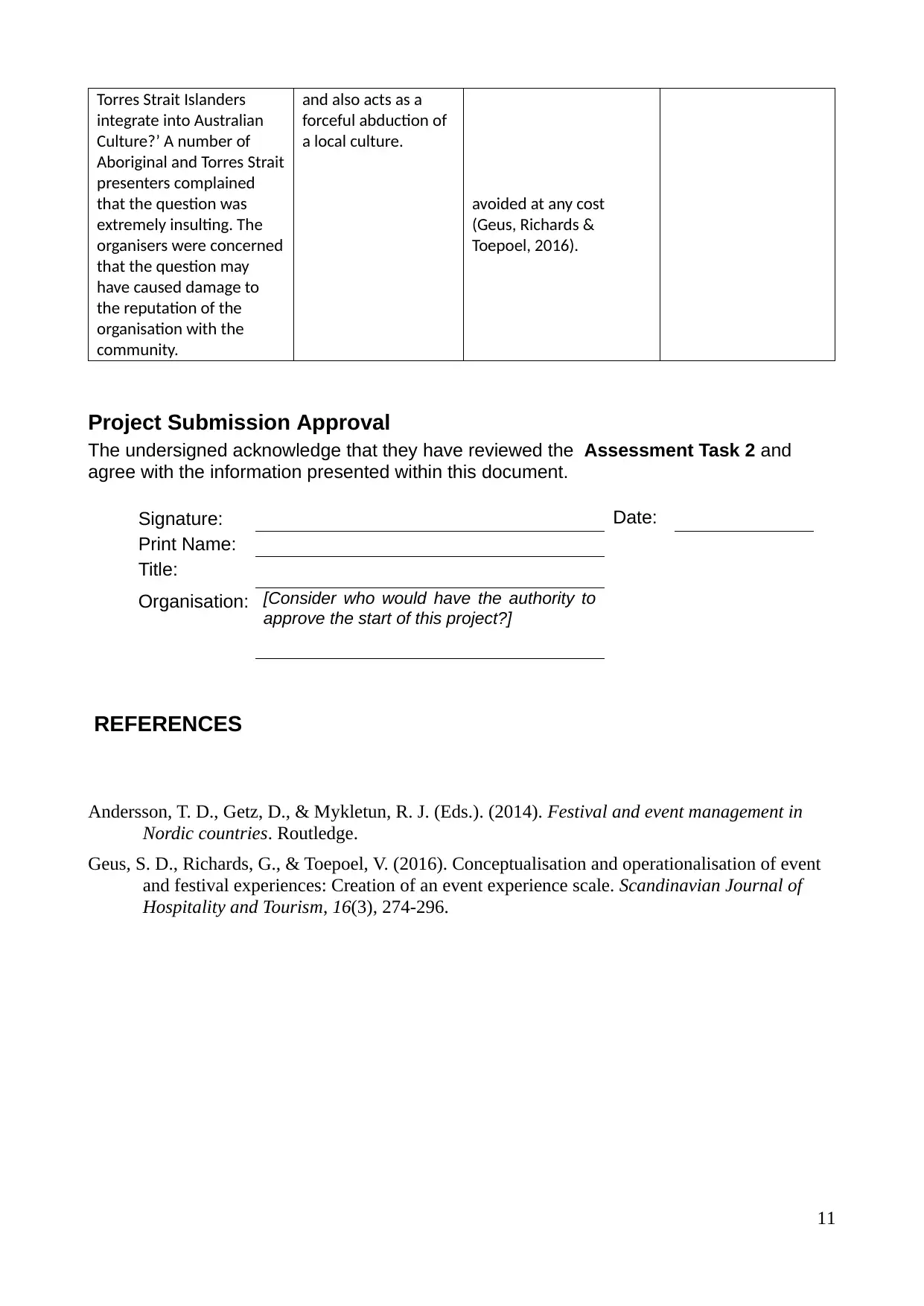
Torres Strait Islanders
integrate into Australian
Culture?’ A number of
Aboriginal and Torres Strait
presenters complained
that the question was
extremely insulting. The
organisers were concerned
that the question may
have caused damage to
the reputation of the
organisation with the
community.
and also acts as a
forceful abduction of
a local culture.
avoided at any cost
(Geus, Richards &
Toepoel, 2016).
Project Submission Approval
The undersigned acknowledge that they have reviewed the Assessment Task 2 and
agree with the information presented within this document.
Signature: Date:
Print Name:
Title:
Organisation: [Consider who would have the authority to
approve the start of this project?]
REFERENCES
Andersson, T. D., Getz, D., & Mykletun, R. J. (Eds.). (2014). Festival and event management in
Nordic countries. Routledge.
Geus, S. D., Richards, G., & Toepoel, V. (2016). Conceptualisation and operationalisation of event
and festival experiences: Creation of an event experience scale. Scandinavian Journal of
Hospitality and Tourism, 16(3), 274-296.
11
integrate into Australian
Culture?’ A number of
Aboriginal and Torres Strait
presenters complained
that the question was
extremely insulting. The
organisers were concerned
that the question may
have caused damage to
the reputation of the
organisation with the
community.
and also acts as a
forceful abduction of
a local culture.
avoided at any cost
(Geus, Richards &
Toepoel, 2016).
Project Submission Approval
The undersigned acknowledge that they have reviewed the Assessment Task 2 and
agree with the information presented within this document.
Signature: Date:
Print Name:
Title:
Organisation: [Consider who would have the authority to
approve the start of this project?]
REFERENCES
Andersson, T. D., Getz, D., & Mykletun, R. J. (Eds.). (2014). Festival and event management in
Nordic countries. Routledge.
Geus, S. D., Richards, G., & Toepoel, V. (2016). Conceptualisation and operationalisation of event
and festival experiences: Creation of an event experience scale. Scandinavian Journal of
Hospitality and Tourism, 16(3), 274-296.
11
1 out of 11
Related Documents
Your All-in-One AI-Powered Toolkit for Academic Success.
+13062052269
info@desklib.com
Available 24*7 on WhatsApp / Email
![[object Object]](/_next/static/media/star-bottom.7253800d.svg)
Unlock your academic potential
Copyright © 2020–2025 A2Z Services. All Rights Reserved. Developed and managed by ZUCOL.





